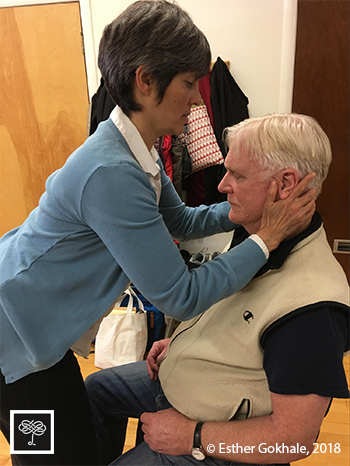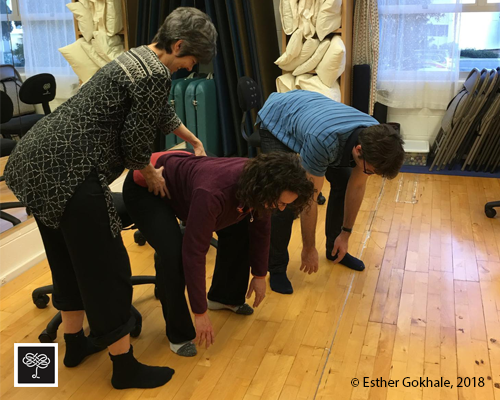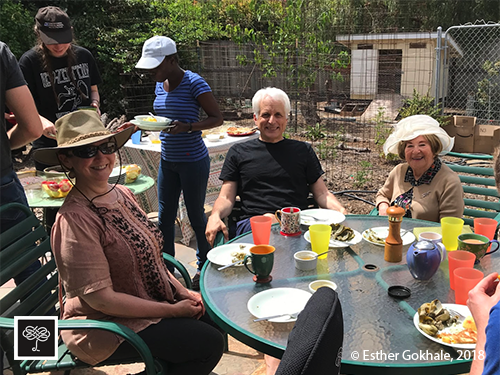Surprising Secret Sauce in the Journey to Pain-Free
After students complete the Foundations Course, we solicit feedback in order to learn from our students and make the course better. Here is select feedback from Marcie, who took the Group Foundations Course with Esther, punctuated by commentary from Esther.
I move easier. When I experience pain, I use it as information to make changes in what I am doing.
Our body is a very intricate 3-dimensional jigsaw puzzle and when we restore each piece back to its home, the parts fit together better. Pain is a very sophisticated feedback mechanism that has evolved; pain is usually trying to tell us we need to be doing something differently.
It's not been linear. Lower back pain decreased, upper back/shoulder pain increased. (That might be my standing desk and increased awareness, though.) I have body awareness but not always useful body awareness. A lot of the time, my awareness is pain. The absence of pain is as foreign to me as the silence of the city sounds that surround me at night. My body is getting used to silence.

Progress is rarely linear. There are usually peaks and troughs. I teach my students to not get too elated by the peaks nor too discouraged by the troughs. Rather, it’s helpful to watch the trend. The most common trajectory we see is that the peaks get higher and higher and the troughs get shallower and less frequent.
The funniest thing is that when I took my garbage out I could hear "tighten your glutes" in my mind. With that came muscle memory of someone bumping my butt, which was simultaneously uncomfortable and helped me engage easier. As I walked, I thought about my foot being held down for a second with bubble gum. Esther really is an amazing teacher, maybe one of the best I've ever encountered and I've had a few great teachers in my lifetime.
Lately, I've been able to apply the techniques as I walk. The way things started to come together on that last day? It's starting to happen when I'm out and about in the world. Not perfect, but progress. I don't think the neighbors suspect anything so I think I'm doing it right.
People learn from repetition. And people learn differently from each other. This is why our course has a rich weave of auditory, visual, and kinesthetic cues running through it. Many of our students are weighted towards understanding the world through their intellect. We carry around very large brains all day long — in our method we decided to put that intellection to use. So we explain what and why we are doing throughout the process. Humans also have enormous visual cortexes — hence all the images in the book and the projected slides in the classes. Kinesthetic learning is usually the slowest for our students, but it’s the most important piece of learning posture — our small classes allow students to get a lot of hands-on guidance. So there’s intellectual, visual, and kinesthetic cueing happening throughout the classes. The techniques need to look right, feel right, and make sense. Having multiple channels allows students with different learning styles to understand the techniques and also to embody them in a more robust way.

Oh, yeah, one more thing . . . I've had the oddest desire to dance and at times actually feel my body contorting to music. Unbelievable.
There are only so many sitting and bending lessons a person is going to want to take in their lifetime. And yet it’s helpful to revisit these patterns to tweak and fine-tune them. Dance provides a wonderful way to revisit posture and movement patterns in ways that remain fresh and invigorating and provide additional physical and mental benefits.
Please list 3 adjectives that describe the Gokhale Foundation course.
Dynamic, Mind Expanding, Community
Please list 3 adjectives that describe the teacher/teaching style.
Thorough, Engaging, Fun
Having taken the course, how would you advise someone with a similar situation to yours?
I'm going through this with John. He wants someone to fix him. He wants to be fixed now. My response is to keep working at the principles and allow them to help you heal you.
In some endeavors, you can get results more efficiently not by working directly on the problem, but by working on something related to — but at a distance from — the problem. Musculoskeletal pain is sometimes like that. Our teachers are trained to work on posture, not directly on symptoms, while maintaining knowledge of how the relevant symptoms are faring. SInce most of our teachers have alternative or conventional medical backgrounds, this constitutes quite a switch from their usual modus operandi. But the results are compelling, and we’ve had several teachers switch their practice mindset to this one. It’s less burdensome to take on the responsibility of massaging muscles (in the case of MTs) or aligning bones (in the case of chiropractors) than fixing symptoms (which is often not in your control). It puts the both teacher / healer and student / patient together on a team making a sincere effort and hoping for a great result.
I think you tend to attract people who are more in their minds than in their bodies. It's tough to teach a transition from one to the other. It's worth doing. Presence matters. It changes everything.

Can you suggest any improvements to the course? Any additional comments?
I hated the idea of being photographed. I completely understood the value of it. I've been having some issues with my body. I've almost always carried more weight than I would like. When I started traveling, then when I fell, it got worse. Through most of my rehab, I've felt like it was in someone else's hands. I'd reached the point where I was afraid of my body because it seemed like everything I did hurt it. During a PT assessment, I was told that I had something like PTSD with my body. It made sense, but I wasn't given a solution to it (for the record, do more squats was NOT the answer. Timing the squats made the anxiety even worse.). There's a light touch around body acceptance. I think it should be pulled out more. Maybe not as a topic, but definitely as a part of the class. There's nowhere else I can think of that has instruction and unconditional acceptance like I found in the class. Esther and the student teachers genuinely loved us (the students). I think that helps allow and cement the changes.
I think as a society we create a lot of our body issues. Class became a laboratory to explore what my body could do and how it could move better. Having people look at my body made me cringe, but the studio really became a safe place to do that sort of work. The attention from the student teachers and from Esther was great because it helped reinforce the ideas.
We have the good fortune to have our own publishing company. We only have one book so far, but with international distribution and possibility for growth, we are indeed a bonafide publishing house. Our publishing house is called Pendo Press, where Pendo means “love” in Swahili. All our teachers learn this some time during their immersion training program, because that name reflects our secret sauce. We don’t talk about this secret sauce, but all our teachers are given the challenge to, within the four walls that make a classroom, find unconditional love in their hearts as part of their offering. We usually succeed.
Maybe the biggest thing that could be overlooked is the idea of community. We don't have that so much in modern society. The small setting. The intimacy. It felt like we were part of a tribe. There were elders to guide us. We had peers to mirror us. It changed the dynamic in social interactions. The potluck dinner really does drive the idea home. It's sad that there are not more opportunities to have that sort of contact with people.
We began having potluck lunches / dinners on day 4 or 5 of Gokhale Method Foundation Courses that overlapped with our teacher training programs.
This was so enjoyable I found myself wanting to expand it to other courses, and now most courses include a potluck get-together. I’m now wondering how to invite more of this kind of precious interaction into my life...

I was blown away by the course. The fact that I am still practicing speaks to Esther's teaching gifts because the method has become a part of how I move. (In fact, I'm intrigued enough by her teaching style that when the timing works, I'd like to take the teacher's training to deconstruct how she teaches more than ever teaching someone else.) I feel more comfortable in my body. I am more aware of it, but not just the aches and the pains — I now have the tools to make it better.
I can't quite remember what my miracle worker line was, but Esther is truly a miracle worker.

Comments
Add New Comment
Login to add commment
Login